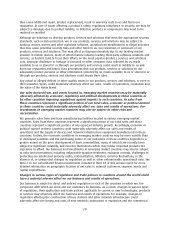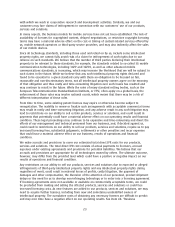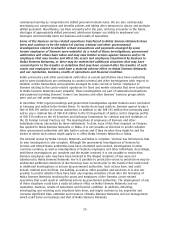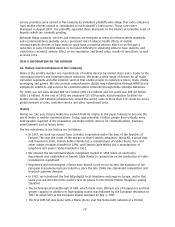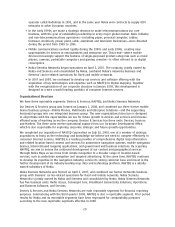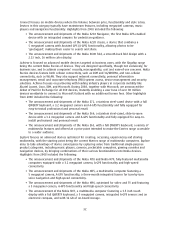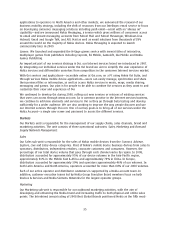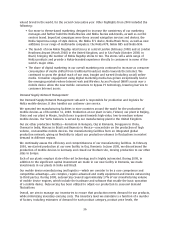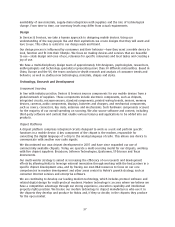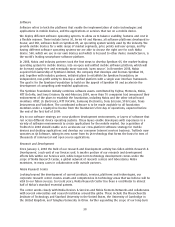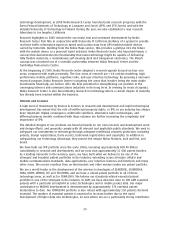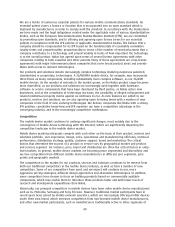Nokia 2008 Annual Report Download - page 31
Download and view the complete annual report
Please find page 31 of the 2008 Nokia annual report below. You can navigate through the pages in the report by either clicking on the pages listed below, or by using the keyword search tool below to find specific information within the annual report.For a breakdown of our net sales and other operating results by category of activity and geographical
location, see Note 2 to our consolidated financial statements included in Item 18 of this annual
report.
Other
We primarily invest in research and development, marketing and building the Nokia brand. However,
over the past few years we have increased our investment in services and software, including
acquiring a number of companies with specific technology assets and expertise. We expect the
amount of capital expenditure (excluding acquisitions) during 2009 to be approximately EUR 700
million, and to be funded from our cash flow from operations. During 2008, our capital expenditures
(excluding acquisitions) totaled EUR 889 million, compared with EUR 715 million in 2007. For further
information regarding capital expenditures see Item 5A. “Operating Results” and for a description of
capital expenditures by our reportable segments see Note 2 to our consolidated financial statements
included in Item 18 of this annual report.
We maintain listings on three major securities exchanges. The principal listing venues for our shares
are NASDAQ OMX Helsinki, in the form of shares, and the New York Stock Exchange, in the form of
American Depositary Shares. In addition, our shares are listed on the Frankfurt Stock Exchange.
Our principal executive office is located at Keilalahdentie 4, P.O. Box 226, FI00045 Nokia Group,
Espoo, Finland and our telephone number is +358 (0) 7 18008000.
4B. Business Overview
Devices & Services
The following discussion should be read in conjunction with Item 3D. “Risk Factors” and “Forward
Looking Statements.”
Overview
The mobile communications industry has evolved rapidly during the past two decades. While today
mobile devices are still used primarily for voice and text message communication, people increasingly
also use them to take and send pictures, listen to music, record video, watch TV, play games, surf the
Internet, check email, navigate, manage their schedules, browse and create documents, and more.
This trend—where mobile devices increasingly support the features of singlepurposed product
categories such as music players, cameras, pocketable computers and gaming consoles—is often
referred to as digital convergence. Multifunctional mobile devices, which are often called converged
devices, smartphones, or multimedia computers, typically feature computerlike and consumer
electronicslike hardware and software. Today, people want to be truly connected, independent of
time and place, in a way that is very personal to them. Nokia’s goal is to create mobile devices in
every price band and every category combined with contextenriched services to deliver compelling
consumer solutions.
A person’s choice of mobile device is influenced by a number of factors, including their purchasing
power, brand awareness, technological skills, fashion consciousness and lifestyle. The global market
for mobile devices is comprised of many different consumer groups and markets with different
characteristics, dynamics and stages of development. We believe that in order to meet our customers’
needs, we need to have a focused, optimallysized offering of commercially appealing mobile devices
with attractive aesthetics, design and a combination of valueadding functionalities that are easy to
discover and use for all major consumer segments and price points designed, as appropriate, for the
local requirements and preferences of different markets and supported by the Nokia brand, quality
and competitive cost structure. Further, we believe a competitive product device portfolio needs to
include leading flagship products, be innovative and ahead of the expectations of the customer and
differentiated positively from our competition. For our services, including map data and related
30


